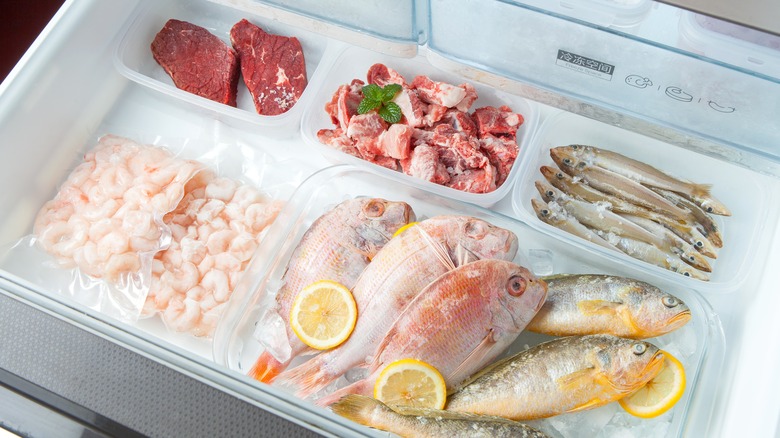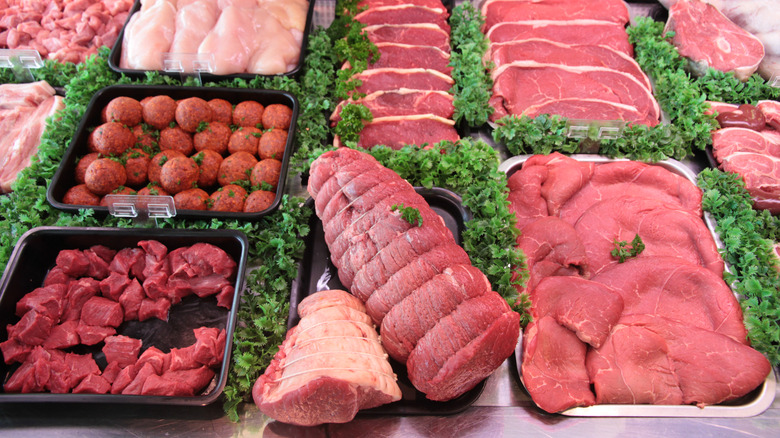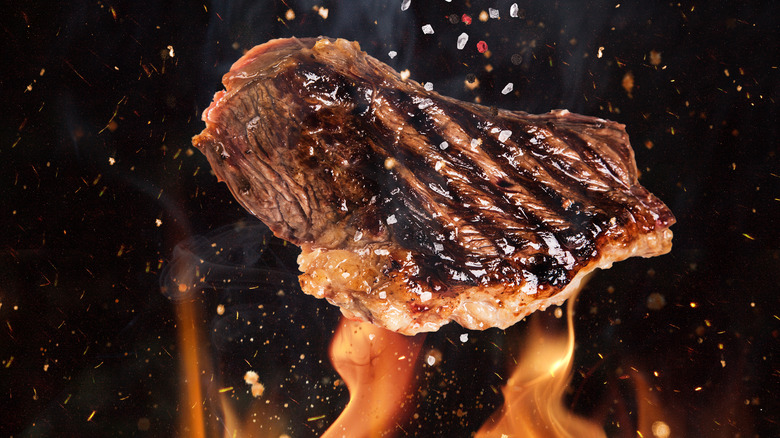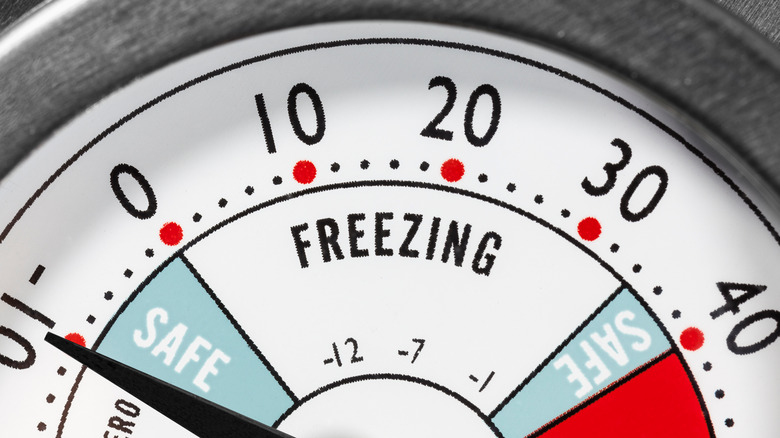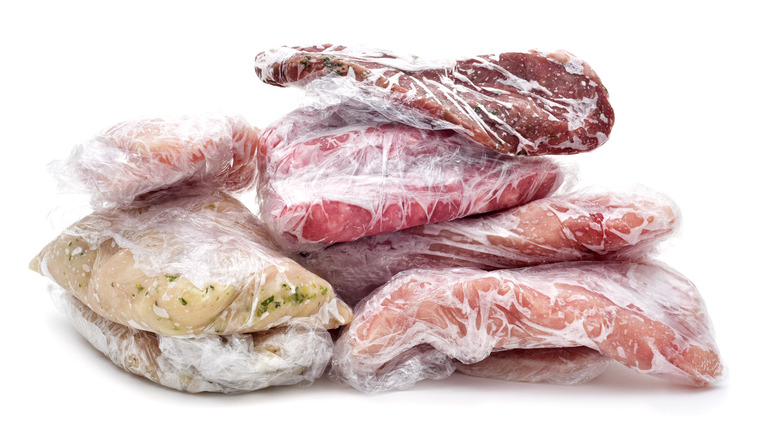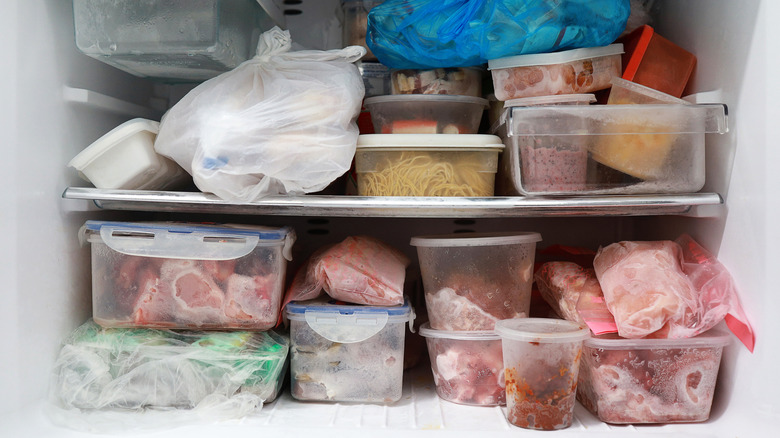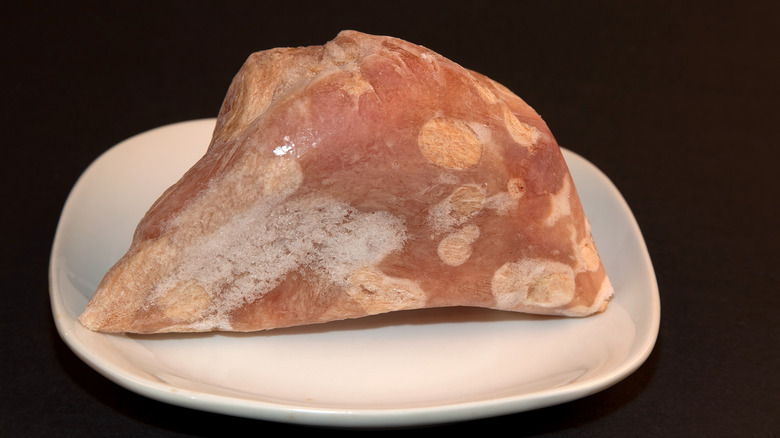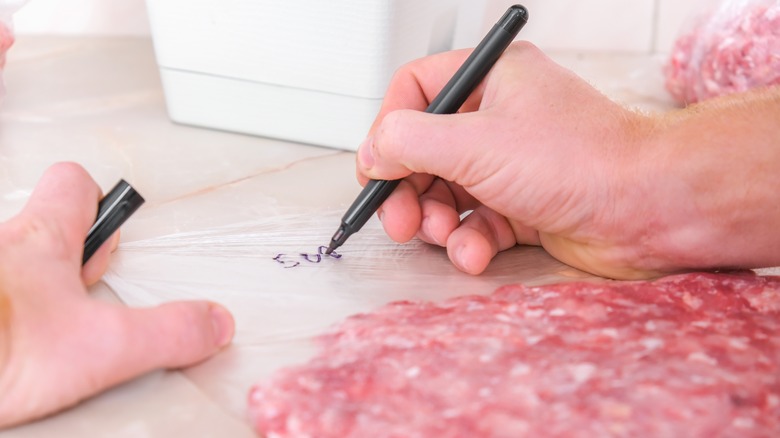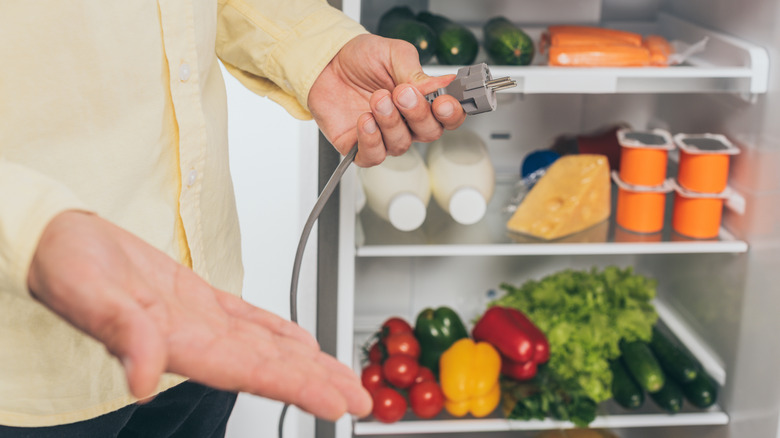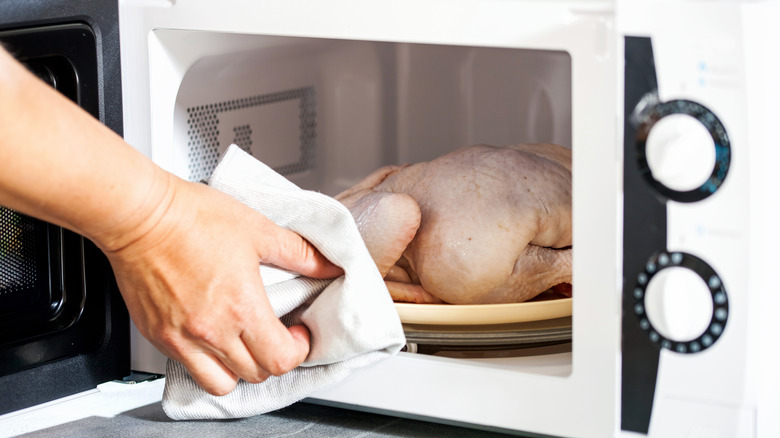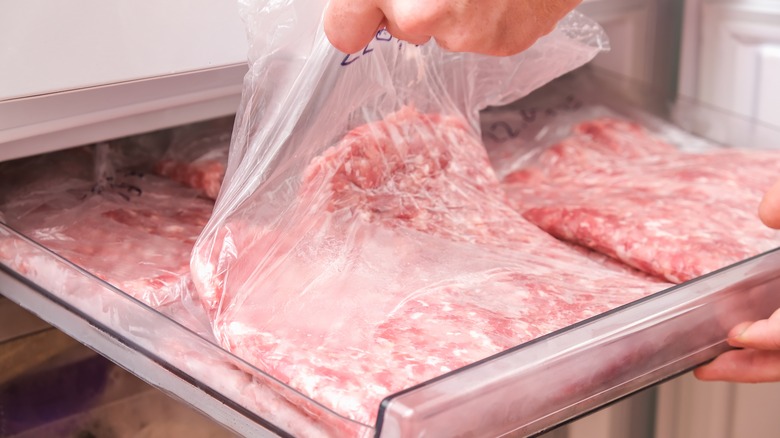A Beginner's Guide On How To Properly Freeze Different Meats
Freezing meat can save time and money, but beginners may not know where to start as they look at packs of ground beef, ribs, and chicken breast. It's not hard, though — you just need to take a few simple steps, and, voila, you'll be making fewer trips to the supermarket and more to your freezer.
Take the Kale family, for example. Open their freezer you'll find enough meat there to feed them for six months, according to Good Morning America. The Kales prefer buying locally at Heartland Farms in Virginia since they know that they'll get a superior product for the same amount as in the grocery store. Mr. Kale admits that purchasing and freezing meat in large quantities was daunting at first, though, since it was a big project and investment. He doesn't regret it now, though.
People planning on preserving meat in their freezer will need some vital information to get started. Understanding how freezers keep food safe and learning about how to prepare and package meat to maintain quality will help people get the most out of their freezers.
What kind of meat can you store in the freezer?
Every kind of meat you can name probably stores well in the freezer. According to the National Center for Home Food Preservation (NCHFP), that includes cuts of beef, veal, lamb, and pork from the supermarket. You can also freeze lean meats like poultry, fish, and seafood, per North Dakota State University. Finally, subzero temperatures will conserve game meats like rabbit, venison, duck, and goose as well.
Keeping meat in the freezer has clear benefits like enabling you to buy in bulk. G. Burbick Farms of Ohio says purchasing a side of beef will mean fewer trips to the grocery store and make it easier to budget. Freezers are a fantastic tool for hunters and people who raise poultry or rabbits.
There's a limit to how much you can or should preserve, though. It will depend on how many people you want to feed and how much room you have in your freezer. People in the U.S. ate an average of 264 pounds of meat per person in 2019, according to the Illinois Farm Doc Daily. Use that number in your calculations and then consider that one cubic foot of freezer space accommodates 35 to 40 pounds of frozen meat, according to a how-to guide by Seven Sons Farms in Indiana. That means that a family of four could store 500 pounds of meat in a freezer with a capacity of at least 13 cubic feet. That amount of meat would last them six months.
Should I cook meat before freezing it?
You have a big haul of ground beef in your trunk — it was on sale at the grocery store, so you decided to stock up. Should you fry it up with some onions and pepper to make taco meat to store in handy, single-meal-size baggies in the freezer? On the other hand, you could simply put some extra plastic wrap on the packages and freeze them. There is no one right choice, just what will be more convenient for your family.
First, the U.S. Department of Agriculture (USDA) says that raw meat maintains its quality longer than cooked meat. Your sauteed taco mix will remain most delicious for two to three months. After that, you can expect it to lose flavor and have a worse texture. You can store raw ground beef for about a month longer, and other cuts of raw meat will last up to a year.
Storing a cooked dish, like taco filling, means that you'll only need to thaw and reheat it to 165 degrees Fahrenheit, according to the USDA. That's easy to do with a microwave. Raw meat, on the other hand, will have to be thoroughly cooked from scratch, which will take longer.
The basics
There are some basic rules for freezing all meat that you'll need to follow. First, the temperature of your freezer should be 0 degrees Fahrenheit or below, according to PennState Extension. Chest freezers, upright freezers, and refrigerators with separate door freezers can all reach and maintain this temperature. Fridges with a freezing area but no separate door cannot. If in doubt, you can use an appliance thermometer to measure the temperature, says Michigan State University Food Preservation Extension.
Next, the USDA says only to freeze meat at peak quality. If you don't plan on using meat soon, conserve it at a low temperature as quickly as possible. Ideally, meat should freeze in under two hours if it's not thicker than two inches. Check your freezer for a special quick-freeze function or shelf to speed things up.
It's important not to overload your freezer. If you put too much meat in at once — for example an entire side of beef — it may not freeze fast enough to maintain top quality. The NCHFP says to only put in what can freeze in 24 hours. That's about three pounds per cubic foot of storage space.
Preparing meat before freezing
There are specific guidelines for freezing different kinds of meat, although some instructions apply to all. The NCHFP says to put all meat in packaging approved for use in the freezer. Make single-meal-sized packs whether you're working with red meat, poultry, fish, or seafood.
For beef and pork cuts, remove as many bones as possible — they take up space and can tear plastic wrap. If the meat is from a recently butchered animal, chill it in the fridge for 24 hours before freezing. The NCHFP notes that you may freeze raw poultry whole — for example a whole chicken or turkey. If you've bought cuts like breasts, thighs, or drumsticks, they are soft enough to easily put in square packages which will stack neatly in your freezer. According to the USDA, you should never rinse meat or poultry before freezing. This could spread dangerous germs around your kitchen counter and sink.
You should rinse fish, though, explains the NCHFP, but only after scraping off the scales, removing the entrails, and cutting off the head and fins. Next, pretreat fish to prevent rancidity. Dip fat fish like trout and salmon in an ascorbic acid solution (two tablespoons to one quart of cold water) for 20 seconds. Dip lean fish like cod in salt brine (1/4 cup salt to one quart of cold water). Finally, put the fish in water in a shallow pan, freeze, and then wrap.
What's the best packaging to use in the freezer?
Meat can get freezer burn, become tasteless, or even turn funny colors when frozen. It's a bummer if that happens to your bulk meat purchase, because you may have to throw it away. Prevent this sad situation by correctly packaging your meat, says Michigan State University Food Preservation Extension. MSU says freezer packaging needs to be moisture vapor resistant and seal easily. It shouldn't be hard to label and must prevent leaks. Plastic wraps, baggies, and Tupperware containers shouldn't become brittle at cold temperatures — if they do, don't use them when freezing meat. Finally, your freezer packaging should protect meat from odors and be grease resistant.
Think about the shape of your meat before selecting packaging. If it's ground beef or comes in smaller cuts, you can pack it into rigid containers. You'll be able to stack these easily and use freezer space more efficiently. If you are working with larger, irregularly shaped cuts, use plastic wrap, heavy-duty aluminum foil, or baggies. Make sure these are labeled freezer friendly. PennState Extension says to squeeze out as much air as possible and cover all openings with wrap or foil. Bones can tear these materials, so remove them.
The USDA says to add an outer layer of wrap to grocery store meat, since their packaging may not be water vapor resistant. Vacuum-packed meat, on the other hand, can be frozen as is.
How to prevent freezer burn
Freezer burn sounds ominous — dangerous even. It's not really. Freezer-burned meat is still safe to eat, but probably won't taste very good according to the USDA. Freezer burn is the result of contact with air. It happens when people wrap foods poorly before freezing or don't let them cool beforehand, according to Iowa State University Extension and Outreach. In the freezer, tiny ice crystals on the surface of food evaporate without becoming liquid water first. This causes the food to dry out and become discolored. Any food with a high water content is more likely to suffer from freezer burn.
You'll recognize freezer burn because it looks like grayish, leathery brown spots on your meat, says the USDA. If it hasn't affected a wide area, you can cut it away. If you find a cut of meat with severe freezer burn, though, the effort of preparing it probably isn't worth it. It will likely taste and smell off.
How long can I leave meat in the freezer?
Food spoils fast because of bacterial growth and enzymes in the food itself. Amazingly, freezers keep food safe almost indefinitely since they impede both of these processes, according to the USDA. Of course, you've likely seen guides with recommended freezing times. That's because food loses quality, making it less pleasant to eat, the longer it remains in the freezer. Always rely on your senses first and guidelines second. If a product has an off smell or taste, throw it out even if it hasn't reached its use-by date.
The USDA recommends these timelines one to two months for bacon, ham, and sausage; four to 12 months for raw roasts and steaks; three or four months for raw ground meet; and two to three months for cooked meat. Whole poultry can keep up to a year, but the USDA specifies a shorter time frame for smaller portions: up to nine months for uncooked poultry, and four months for cooked. Wild game can keep for eight months to a year.
What should I do if there's a power outage?
In 2017, people shared on social media that they kept glasses of ice with coins on top in their freezers, according to Snopes. If there was a hurricane and they had to evacuate their homes, they'd know if the items in their freezers had thawed since the coin would fall to the bottom of the glass if the water melted. Although the fact-checking agency debunked this tip as "mostly-false," it raises the question of what to do when the power goes out.
FEMA says a full freezer will keep food at safe temperatures for 48 hours if it stays shut. That's the first rule, then: When there's a blackout, don't open your freezer no matter how much you want to. Check the temperature with an appliance thermometer, and if food gets to over 40 degrees Fahrenheit for more than two hours, it should be thrown out.
USDA says that in the case of a power outage, meat and poultry should be separated from other items in the freezer. That way, if they drip, the liquid with not fall on other foods. Since you shouldn't open your freezer while the power's out, make sure you always keep meat and poultry in one area of your freezer and other items elsewhere. Be prepared.
Thawing frozen meat
It's dinnertime but your meat is hard and frozen. The University of Nebraska Lincoln Extension says you have four options: 1) cook it frozen, 2) microwave it, 3) use cold water, or 4) thaw it in the fridge.
If you cook frozen meat, the best results will be seen with thin items like hamburgers, according to PennState University Extension. Be sure to check the internal temperature of frozen meat that's cooked without thawing to ensure the cut has reached a minimum safe temperature. Remember that you'll have to cook the meat longer this way– one and a half times the normal length. If you usually grill a burger in 10 minutes, frozen, it will take 15. Microwave lovers should cook thawed meat immediately after nuking it. The appliance creates bacteria-friendly temperatures. Don't forget to enjoy the special defrosting functions on your microwave. They use a lower power for more even thawing.
If you're good at planning, thaw meat in the fridge. Small items thaw overnight, and larger cuts take a day or two. A pound of chicken breast thaws in 24 hours, while large turkeys need a day for every five pounds. Leave thawing meat on the lowest shelf so it won't drip on other food. Finally, cold-water baths are quicker but more labor intensive than fridges. Put meat in water-proof bags and then place the bags in cold water. Change the water every 30 minutes. This thaws a pound of meat in less than an hour. Plan a half hour for every pound for larger cuts.
Is it safe to refreeze meat?
You planned out all your meals for the week, went to the freezer, pulled out the meat you'd need, and left it thawing on the bottom shelf of your fridge. But nothing ever goes as planned, and you were invited to a friend's house on Wednesday and ended up heading to McDonald's on Thursday. Now you have a bunch of extra meat sitting there in your fridge and no desire to cook it all up for later. No problem, the USDA says you can refreeze raw meat as long as you thawed it in the fridge and it didn't get above 40 degrees Fahrenheit. Likewise, you can refreeze thawed meat purchased at the supermarket as long as it's been properly handled.
There's always a downside, though. The PennState Extension says that refrozen meat may display changes in color, become dry, or get freezer burn. So, try to thaw only the amount that you need and not to refreeze meat too often.
